Author: DappRadar
Translated by: Felix, PANews
Despite Bitcoin reaching new highs in the first week of October, the third quarter of 2025 has laid a perfect foundation for year-end developments. Dapps have been affected by the downturn in the crypto market, but innovation has never ceased. Over the past three months, we have witnessed the continued rise of Dapps, with tokenization becoming an important pillar of the industry, NFTs gaining momentum, and DeFi TVL reaching an all-time high.
Key Points:
- The average daily active wallets for Dapps was 18.7 million, a decrease of 22.4% from the previous quarter.
- Gaming solidified its market dominance, growing from 20.1% in Q2 to 25% in Q3. NFTs (18.5%) and DeFi (17.9%) followed closely behind.
- DeFi's TVL reached an all-time high, with a total of $237 billion locked across all blockchains and protocols.
- NFT trading volume nearly doubled this quarter, reaching $1.58 billion. Meanwhile, NFT sales hit a quarterly high of 18.1 million.
- Sports became a major growth market for NFTs, with trading volume increasing by 337% to $71.1 million.
- Losses from hacking attacks fell to a yearly low of $434 million, but threats have become increasingly complex.
1. Dapp Usage Declines as SocialFi and AI Momentum Weakens
The number of daily active unique wallets for Dapps decreased by 22.4%. In Q3, Dapps attracted an average of 18.7 million wallets daily. Throughout the quarter, the number of active wallets in each category declined, with the social and AI categories seeing the most significant drops.
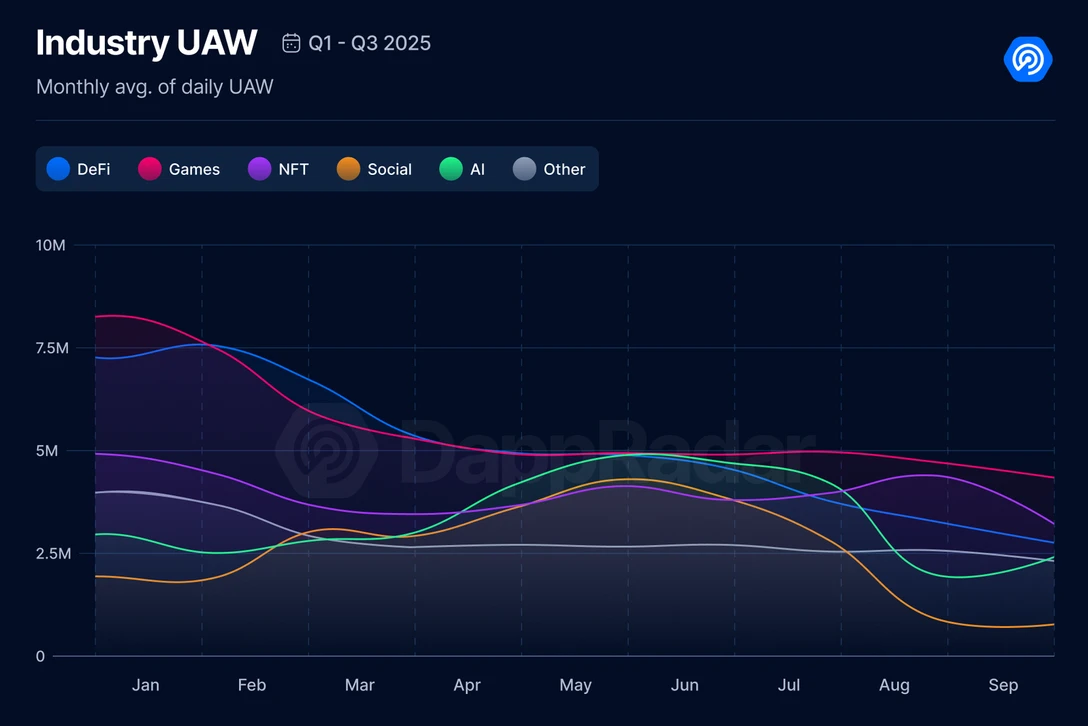
Throughout the quarter, the appeal of the AI category diminished, with the average number of active wallets dropping from 4.8 million in Q2 to 3.1 million in Q3. This downward trend is evident in the success of the AI agent launch platform, Virtuals Protocol. In Q2, Virtuals Protocol attracted 10,000 active wallets daily, with millions of users flocking to the platform. Now, it attracts only 1,000 to 1,500 active wallets daily, with an average daily trading volume of about $100,000.
In addition to AI, social Dapps have also been impacted. In Q2, social Dapps had 3.8 million daily active wallets. In Q3, this number plummeted by more than half to 1.57 million active wallets. Various social Dapps like The Arena, Layer3, and OnchainGM peaked in Q2 but saw significant declines in activity over the past three months.
When segmented by market domain, both social and AI categories lost market share over the past quarter. In Q2, AI was the third most active market domain, accounting for 18.6%, but this dropped to 16.8% in Q3. The social domain was hit harder, falling from 15.9% to 8.4%. In terms of market dominance, NFTs gained market share, currently holding 18.5% and ranking second. Meanwhile, the gaming category remains dominant in the Dapp industry with a market share of 25%.
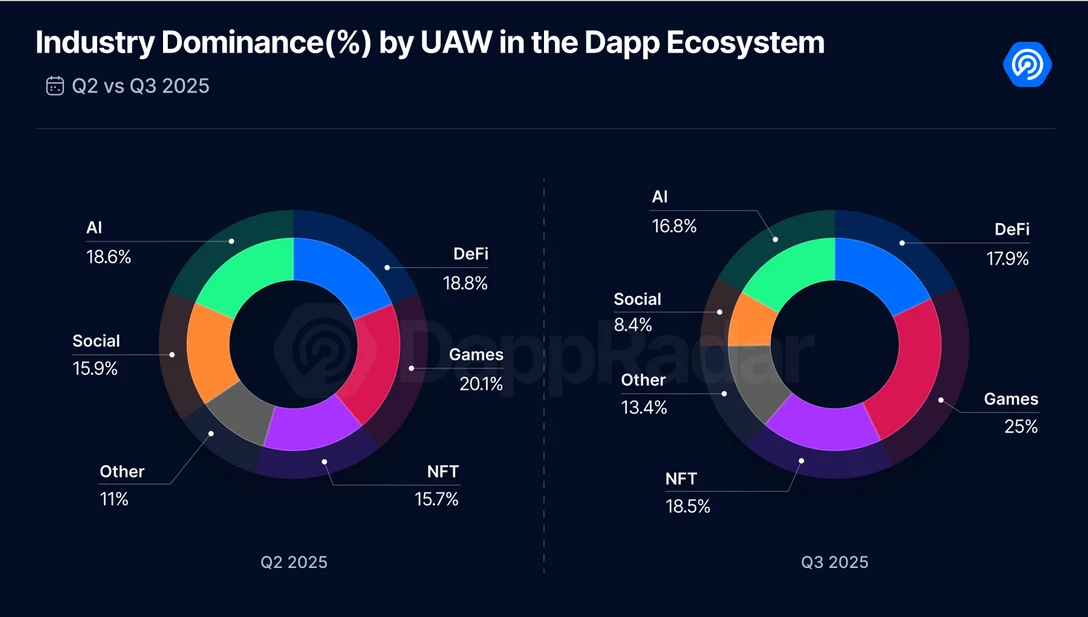
Earlier this year, gaming, DeFi, and AI dominated, with social and NFTs following closely. The situation reversed in Q3. Gaming still holds the top position, but NFTs have risen in rank to second. DeFi and AI follow closely, while social is now the weakest area in the market, surpassed by a diverse range of Dapps in the "other" category.
Looking at individual Dapps, gaming Dapps still dominate. Although the shopping app KAI-CHING attracted the most active wallets, a significant portion of the top five Dapps are gaming-related. "World of Dypians" is a social gaming metaverse, HOT Protocol offers gamified services, and KGeN is an interactive gaming platform.
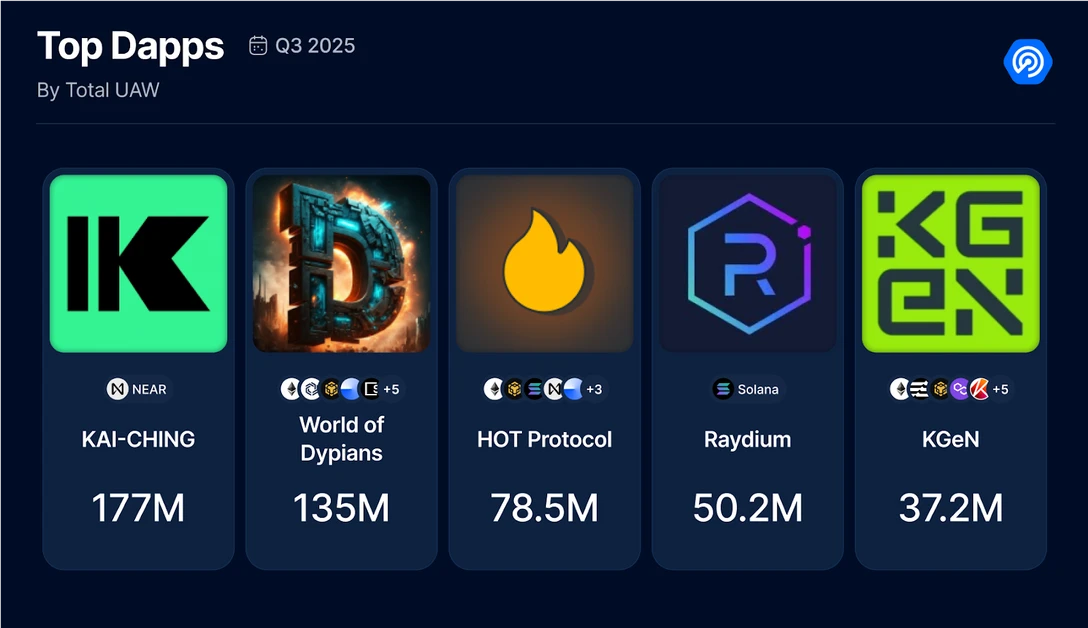
2. DeFi TVL Reaches $237 Billion, Setting a New Record
With the rise in cryptocurrency prices, innovation is pushing the DeFi market to historical highs. Lending protocols are thriving, cross-chain liquidity has become a hot topic in the industry, and the rise of meme coins and AI tokens has brought significant liquidity to certain ecosystems. Additionally, the emergence of stablecoins is bringing DeFi into the spotlight of traditional finance.
In Q3, the U.S. passed three pieces of cryptocurrency legislation, with the GENIU Act being particularly notable. This act provides the first legal framework for payment stablecoins, requiring issuers to hold cash reserves or short-term U.S. Treasury bonds. Meanwhile, corporations and investment funds have poured billions into Bitcoin through Bitcoin ETFs. The launch of the stablecoin chain Plasma, along with announcements from companies like Circle and PayPal to launch networks, highlights the demand from traditional financial institutions for this cryptocurrency version of the dollar, euro, won, or yen.
Against this backdrop, the DeFi sector set a new TVL record. By the end of Q3, $237 billion was locked in DeFi smart contracts. This is the highest record ever, and with the development of real-world asset tokenization and ongoing advancements in stablecoin-related fields, this could mark the beginning of a significant influx of liquidity.
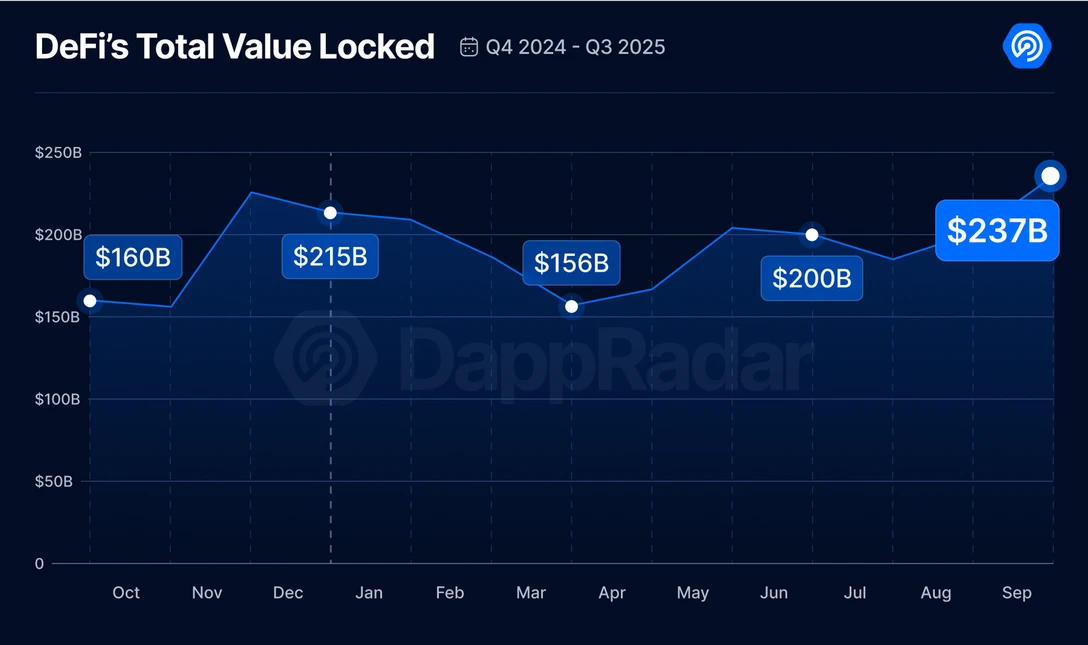
However, despite Ethereum being the leader in the DeFi space, it did not steal the spotlight in Q3. While Ethereum still leads with a TVL of $119 billion, its TVL has decreased by 4%.
Solana successfully maintained its second position but experienced the largest decline among the top ten blockchains. Solana's TVL dropped by 33% to $13.8 billion, primarily due to the waning momentum surrounding Pump.fun and meme coins.
The situation for the other eight blockchains on the list is much more optimistic. BNB Chain launched the perpetual DEX Aster, creating a buzz. Hyperliquid, designed for on-chain perpetual trading, has also been in the spotlight over the past year, with its TVL growing by 29% to $2.85 billion. This is also a trend in this quarter, as DEX functionalities are gradually becoming as rich as those of CEX.
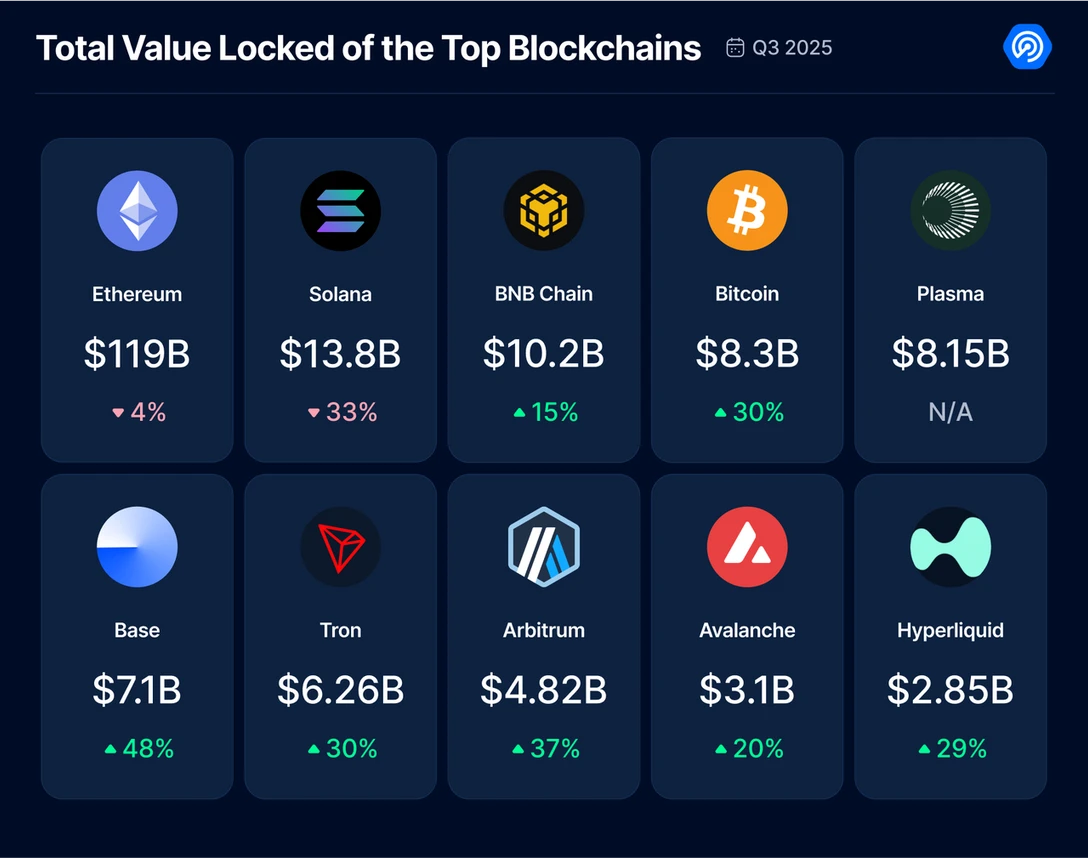
3. NFT Sales Volume Hits a New High Since 2022
Although many NFTs are currently trading at lower prices, trading volume has slightly decreased. However, the number of transactions in 2025 has increased. The first quarter recorded 7 million NFT sales, which rose to 12.5 million in the second quarter. This upward trend continues. In the third quarter, the market recorded over 18.1 million NFT sales, generating $1.6 billion in trading volume.
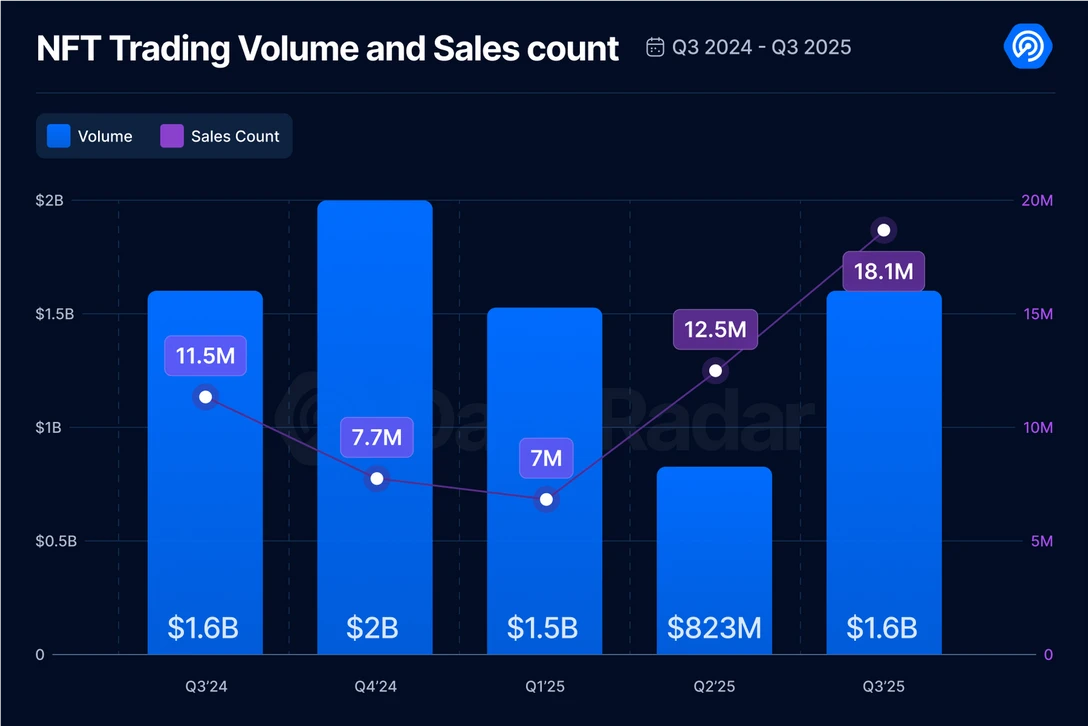
The increase in sales volume is not reflected in actual usage. Although the number of NFT traders reached the highest monthly count in 12 months, the increase is minimal compared to the sales volume.
In the first quarter of 2025, 1.66 million wallets traded NFTs. During the same period, 7 million NFTs were sold, meaning each wallet traded an average of 4.2 NFTs. In Q3, 2.14 million wallets traded 18.1 million NFT assets, averaging 8.4 NFTs per wallet.
Between the two quarters, sales increased by 158%. However, the number of wallets only grew by 28.6%. This indicates strong support from existing participants rather than a massive influx of new users.
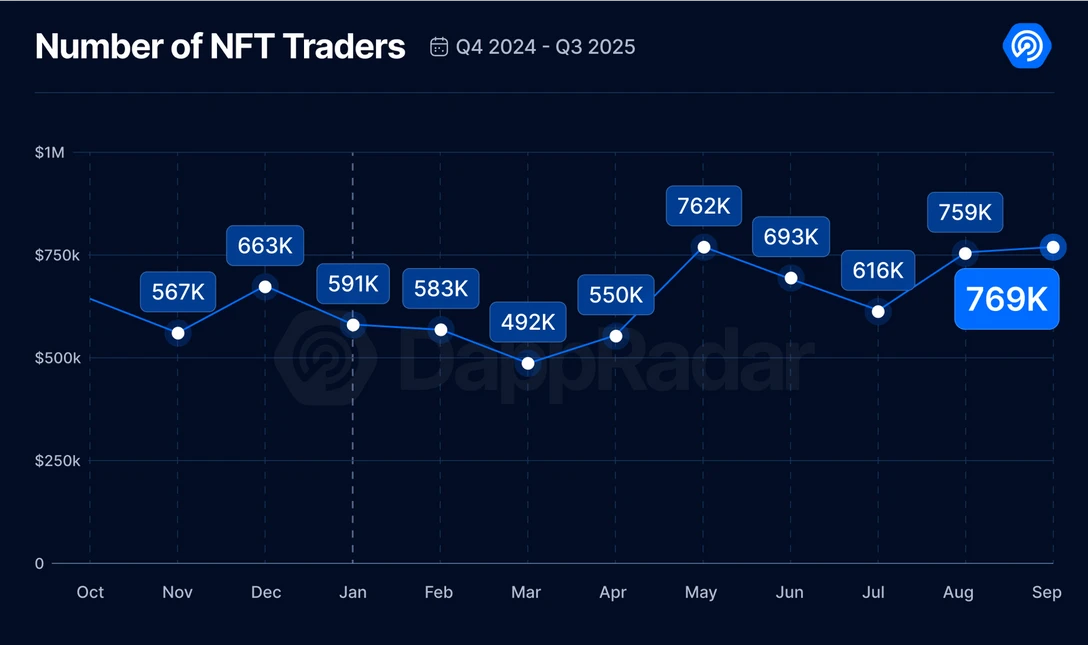
The only NFT category to see a decline is gaming. Over the past quarter, trading volume for gaming NFTs fell by 17%, while the number sold dropped by 32%. In contrast, trading volume for sports NFTs grew by 337% to $71 million, with sales increasing by 143% to 4.1 million.
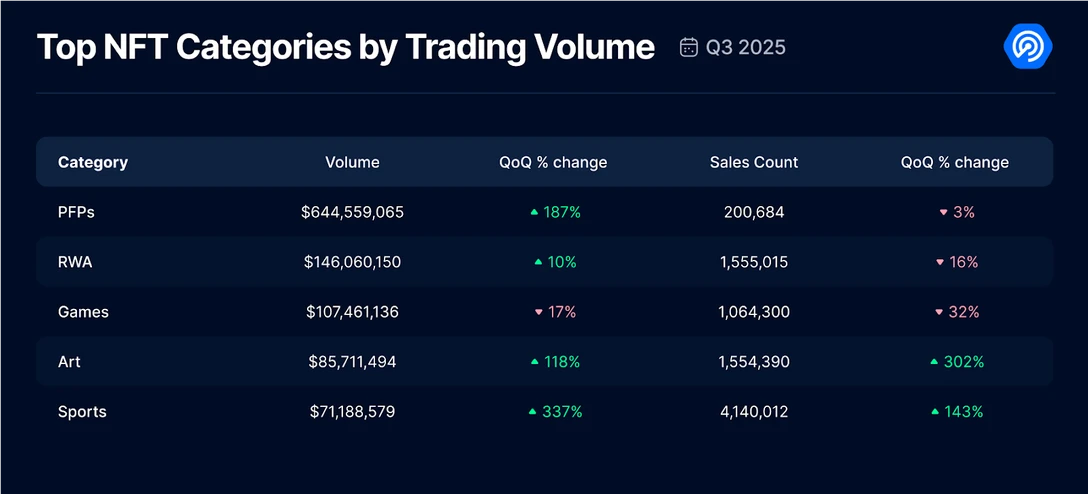
The surge in trading volume is also attributed to certain developments. For instance, OpenSea launched a campaign for its upcoming token while rewarding its most active traders on the platform. This prompted users to start trading low-value NFTs to meet daily standards. OpenSea successfully increased its sales volume by 29%, reaching 9.27 million assets.
Meanwhile, PFP (Profile Picture) NFTs, led by CryptoPunks, Moonbirds, BAYC, and Pudgy Penguins, gained attention. PFP trading volume increased by 187% quarter-over-quarter, reaching $544 million. While CryptoPunks remains the holy grail for NFT collectors, Pudgy Penguins is gradually evolving into an entertainment brand integrated into Web3, encompassing gaming and other forms of entertainment.
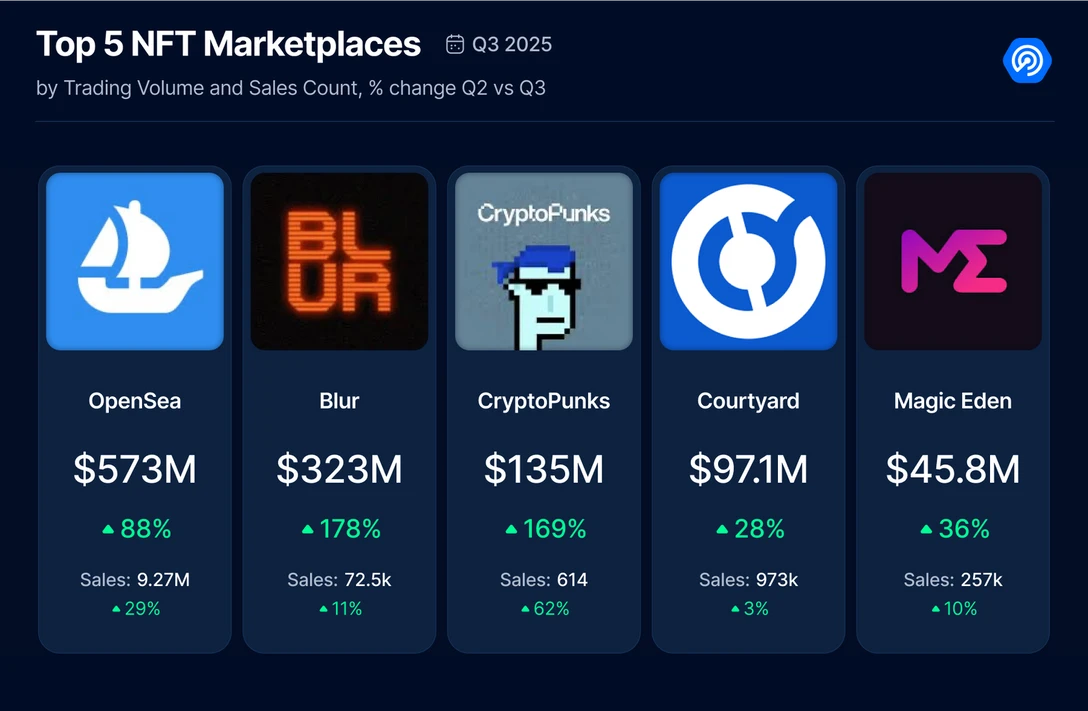
Yuga Labs, the company behind the Bored Ape Yacht Club, sold off some assets to focus on BAYC, MAYC, and Otherside. This has brought some new energy to the Bored Ape community. However, they did sell Moonbirds.
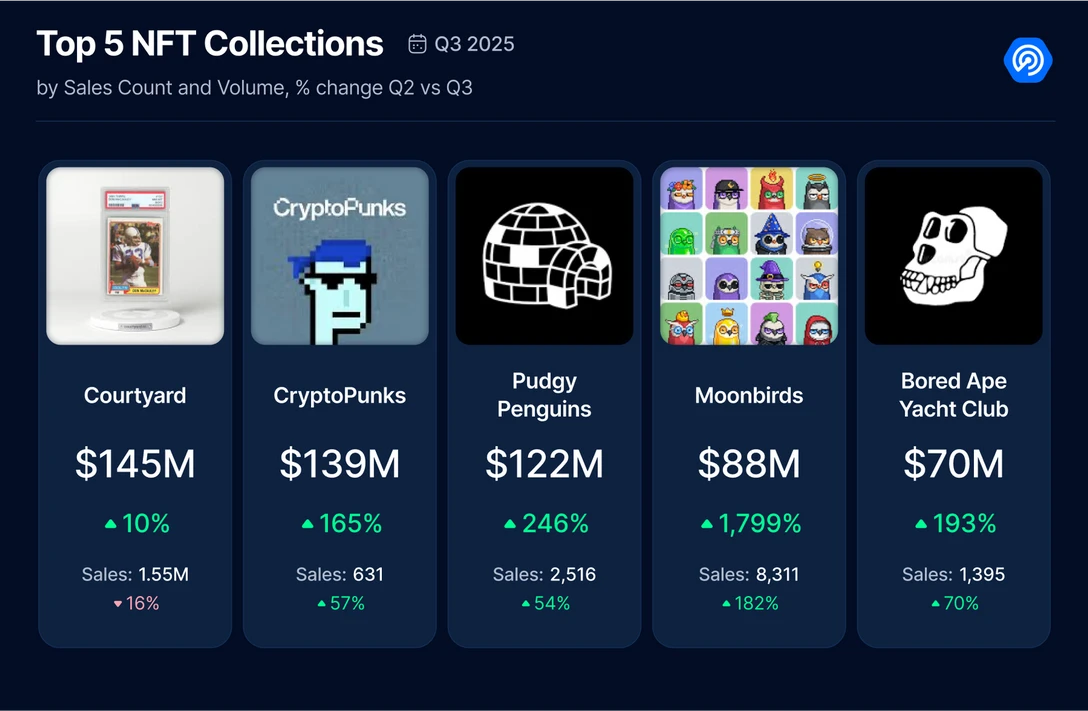
Moonbirds has become a standout project this quarter with 8,311 NFTs sold and $88 million in trading volume. The IP of Moonbirds is now owned by Orange Cap Games, which announced plans in the first week of October to introduce the BIRB token to Solana.
Setting aside the data, real transformation is quietly taking place. NFTs are no longer just JPEG images of monkeys; they are merging with the emerging RWA trend and DeFi.
The leading NFT series is Courtyard, which tokenizes physical collectible cards and sells them on the blockchain as NFTs. Each NFT on Courtyard represents a tokenized physical trading card, such as Pokémon cards or baseball cards. Users can trade digital versions of physical collectibles or redeem them for the physical cards. In Q3 alone, Courtyard sold 1.55 million items, generating over $145 million in trading volume.
A new trend emerged in September: NFT micro-strategies. Token Works launched an automated protocol concept called PunkStrategy for buying and selling CryptoPunks assets. Users acquire PNKSTR tokens, and 10% of the trading fees go into a fund pool. Once the protocol raises enough funds, it purchases the cheapest CryptoPunk and lists it for sale at a price 20% higher than the purchase price.
When a CryptoPunk is sold on the open market, the protocol uses the obtained ETH to buy PNKSTR from the market. These tokens are then burned, exiting circulation. Thus, PNKSTR becomes a way to access CryptoPunks without having to purchase expensive NFTs.
NFTs are no longer just about collecting. These digital assets can represent ownership of physical assets and can also become part of automated DeFi protocols.
4. Hacker Threats Never Cease, $434 Million Stolen

In Q3, hackers stole over $434 million worth of cryptocurrency. The largest attack involved social engineering and exploitation of vulnerabilities. In July, a hacker manipulated internal accounting security measures using a malicious contract from GMX V1, allowing them to withdraw funds beyond what they were entitled to, resulting in a loss of $42 million. A few days later, CoinDCX lost $44 million due to a server breach.
A recent incident in September involved the social project UXLINK, which suffered a multi-signature vulnerability attack, leading to the theft of assets worth $21.7 million. Additionally, the hacker gained unauthorized minting rights and issued 1 billion UXLINK tokens. The sell-off caused the token's value to drop by 70%. Ironically, the hacker later lost tokens worth $48 million due to a phishing attack.
The second largest event in Q3 was the hacking of the Turkish exchange BTCTurk. However, the top incident involved a victim who lost 783 Bitcoins (approximately $91 million) through a social engineering scam. The attacker deceived the victim by impersonating customer service from exchanges and wallets. Specific details are unknown, but with the rise of AI tools, such attacks seem more likely to occur.
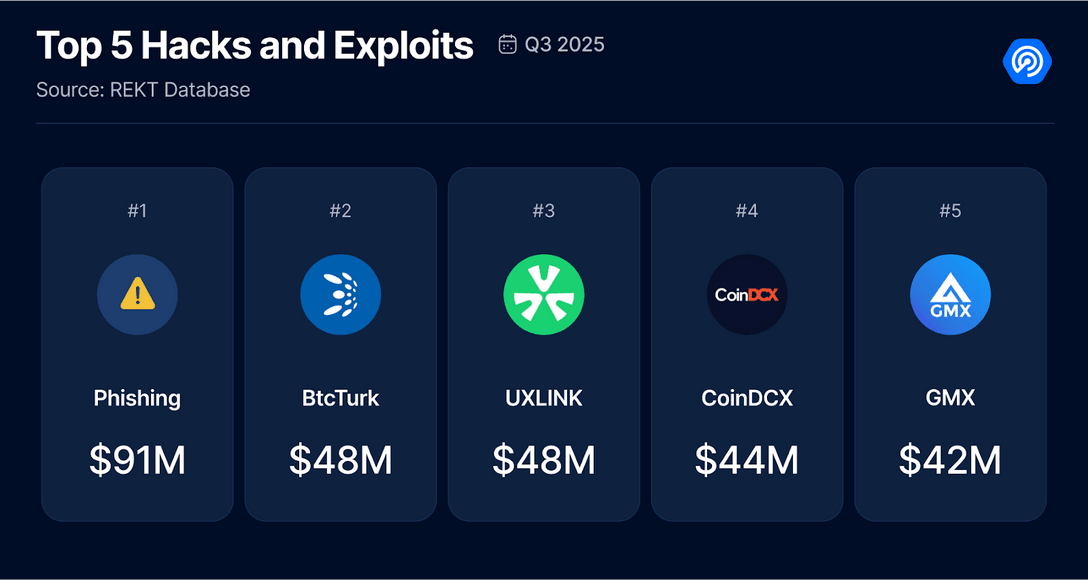
These five incidents accounted for the majority of stolen funds in the third quarter. The total amount stolen reached $434 million, and the intensity of attacks this quarter seems to have weakened. However, with the tokenization of real-world assets, the rise of more advanced DeFi functionalities, and institutions seeking to adopt stablecoins, it is certain that crypto wallets will always be targets for scammers and hackers. Recent reports regarding iOS operating system and WhatsApp zero-click vulnerabilities indicate that crypto users need to remain vigilant.
Conclusion
Q3 showcased the resilience and adaptability of Dapps in the rapidly changing crypto market. Despite a decline in daily active wallets and challenges in the SocialFi and AI sectors, Dapps continue to move forward steadily, achieving significant milestones. DeFi's TVL set a record of $237 billion, indicating strong growth and increasing interest from institutional investors, particularly in stablecoins and tokenized assets.
The NFT market's sales surged to 18.1 million, highlighting its evolving role, which has transcended collectibles to merge with DeFi and real-world assets. The gaming sector remains dominant.
Dapps are gradually reaching the lives of everyday users seeking financial services, fun games, or rare Pokémon cards. Currently, the number of active wallets is in the millions, but it will soon reach billions.
Related Articles: August Dapp Report: On-chain Activity Cools, NFTs Continue to Warm Up
免责声明:本文章仅代表作者个人观点,不代表本平台的立场和观点。本文章仅供信息分享,不构成对任何人的任何投资建议。用户与作者之间的任何争议,与本平台无关。如网页中刊载的文章或图片涉及侵权,请提供相关的权利证明和身份证明发送邮件到support@aicoin.com,本平台相关工作人员将会进行核查。



